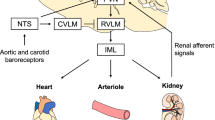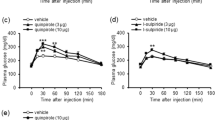Abstract
DOPAMINE has several unique actions in the central nervous system (CNS)—particularly the striatum—and in blood vessels, which seem to be due to interactions with specific receptors1,2. It is not known whether the vascular and CNS effects are mediated by actions on the same or different receptors. To demonstrate receptor identity, classical receptor theory requires that tissues respond in the same rank order to a series of agonists of varying potency3. Remarkable similarities have been revealed in the relative efficacy of dopamine agonists in dilating canine renal blood vessels4 and in increasing dopamine-sensitive cyclic AMP accumulation in homogenates of rat striatum9. Further characterisation has been restricted for lack of additional agonists to extend the potency series. We describe here a comparison of the actions of two recently described dopamine agonists, 2-amino-6,7-dihydroxy-l,2,3,4-tetrahydro-naphthalene (ADTN) and 6-propyl-norapomorphine (PNA) with dopamine and apomorphine in the canine renal and mesenteric vascular beds. Apomorphine, which has structural similarities to dopamine, causes dopamine-like vasodilation4 and increases cyclic AMP accumulation in rat striatum5 but is much less potent and efficacious than dopamine in both systems. Woodruff et al.6 found that ADTN exerted dopamine-like actions in the CNS of mice and resembled dopamine in decreasing blood pressure in guinea pigs. ADTN is equipotent with dopamine in increasing cyclic AMP accumulation in rat striatal homogenates5, and intra-striatal injections of ADTN in rats and guinea pigs produce a dyskinetic phenomenon characteristic of dopamine-like agents7,8. Cannon9,10 suggested that PNA was a dopamine agonist on the basis of its emetic potency in the anaesthetised dog.
This is a preview of subscription content, access via your institution
Access options
Subscribe to this journal
Receive 51 print issues and online access
$199.00 per year
only $3.90 per issue
Buy this article
- Purchase on Springer Link
- Instant access to full article PDF
Prices may be subject to local taxes which are calculated during checkout
Similar content being viewed by others
References
Iversen, L. L., Science, 188, 1084–1089 (1975).
Goldberg, L. I., Pharmac. Rev., 1–29 (1972).
Furchgott, R. F., in Catecholamines (edit. by Blashko, H., and Sandler, M.,) 283–335 (Sprinper, Berlin, 1972).
Goldberg, L. I., Sonneville, P. F., and McNay, J. L., J. Pharmac. exp. Ther., 63, 188–197 (1968).
Miller, R. J., Horn, A. S., Iversen, L. L., and Pinder, R. M., Nature, 250, 238–241 (1974).
Woodruff, G. N., Elkhawad, A. O., and Pinder, R. M., Eur. J. Pharmac., 45, 80–86 (1974).
Costall, B., Naylor, R. J., and Pinder, R. M., J. Pharm. Pharmac., 26, 753–762 (1974).
Costall, B., Naylor, R. J., and Pinder, R. M., Eur. J. Pharmac., 31, 94–109 (1975).
Cannon, J. B., Adv. Neurol.., 9, 177–183 (1975).
Koch, M. D., Cannon, J. D., and Burkman, A. M., J. med. Chem., 11, 977–981, (1968).
McNay, J. L., Goldberg, L. I., J. Pharmac. exp. Ther., 151, 23–31 (1966).
Yeh, B. K., McNay, J. L., and Goldberg, L. I., J. Pharmac. exp. Ther., 168, 303–309 (1969).
Goldberg, L. I., Biochem.Pharmac., 24, 651–653 (1975).
Goldberg, L. I., Adv. Neurol., 9, 53–56 (1975).
Author information
Authors and Affiliations
Rights and permissions
About this article
Cite this article
CRUMLY, H., PINDER, R., HINSHAW, W. et al. Dopamine-like renal and mesenteric vasodilation caused by apomorphine 6-propylnorapomorphine and 2-amino-6, 7-dihydroxy-l,2,3,4-tetrahydronaphthalene. Nature 259, 584–587 (1976). https://doi.org/10.1038/259584a0
Received:
Accepted:
Issue Date:
DOI: https://doi.org/10.1038/259584a0
This article is cited by
-
Effect of isoprenaline on dopamine receptors in the rabbit isolated renal artery
Experientia (1981)
-
A new dopaminergic prodrug
Nature (1978)
Comments
By submitting a comment you agree to abide by our Terms and Community Guidelines. If you find something abusive or that does not comply with our terms or guidelines please flag it as inappropriate.



